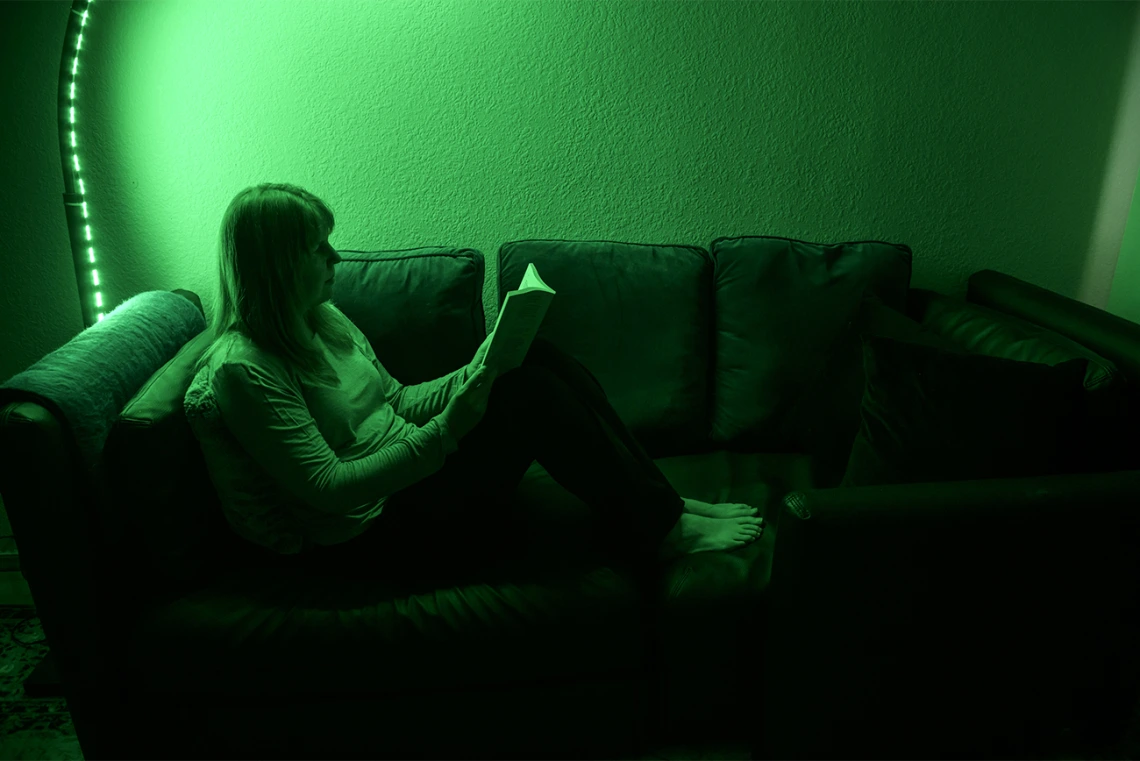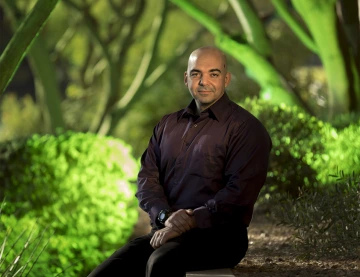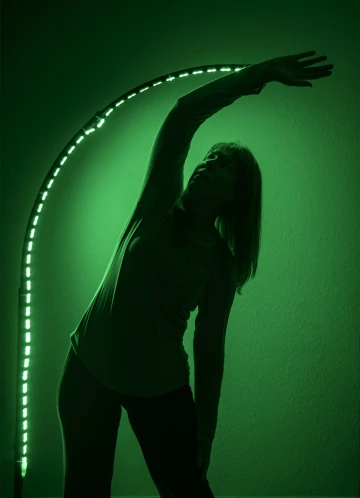Shining a Green Light on a New Preventive Therapy for Migraine
People who suffer from migraine are reducing their pain and improving their quality of life thanks to pain specialists at the University of Arizona Health Sciences and their green light research.

In the United States, nearly 1 in 4 households includes someone with migraine, a neurological disease with extremely incapacitating symptoms, and almost everyone knows someone who suffers from migraine headaches.
According to the Migraine Research Foundation, more than 90% of sufferers are unable to function normally during their migraine, which can be accompanied by visual disturbances, nausea, vomiting, dizziness, extreme sensitivity to sound, light, touch and smell, and tingling or numbness in the extremities or face.
Migraine can also be difficult for physicians to treat. Traditional therapies range from oral medications, which may have side effects, to Botox injections, nerve blocks or implantable nerve stimulators – each with varying degrees of success. But a new potential treatment that uses green light exposure is offering people who suffer from migraine new hope thanks to researchers at the University of Arizona Health Sciences.
Real People, Real Migraines, Real Data

Mohab Ibrahim, MD, PhD, specializes in pain medicine and focuses his research on non-opioid pain relief options, including green light exposure therapy.
Mohab Ibrahim, MD, PhD, and Amol Patwardhan, MD, PhD, both of whom are affiliated with the Comprehensive Center for Pain and Addiction, a strategic initiative of UArizona Health Sciences, have been studying the effects of green light exposure in rodents for several years. Recently Dr. Ibrahim led a research team that completed the first clinical study to evaluate green light exposure as a potential preventive therapy for patients with migraine.
“Migraine is one of the most common neurological conditions in the world, and it's debilitating,” said Dr. Ibrahim, lead author of the study, associate professor in the UArizona College of Medicine – Tucson’s Department of Anesthesiology, Pharmacology, and Neurosurgery and director of the Chronic Pain Management Clinic.
Twenty-nine participants, all of whom had failed multiple traditional therapies for migraine, were prescribed green light exposure as part of the study.
“In this trial, we treated green light as a drug,” Dr. Ibrahim said. “It's not any green light; it has to be the right intensity, the right frequency, the right exposure time and the right exposure methods. Just like with medications, there is a sweet spot with light.”
Overall, green light exposure reduced the number of headache days per month by an average of about 60%. A majority of participants in the study reported a more than 50% reduction in headache days per month.

Green light of a specific wavelength and intensity reduced the frequency and intensity of migraine headaches, along with providing other quality of life benefits.
“Despite recent advances, the treatment of migraine headaches is still a challenge,” said Dr. Patwardhan, who is an associate professor and vice chair of research in the Department of Anesthesiology. “The use of a nonpharmacological therapy such as green light can be of tremendous help to a variety of patients that either do not want to be on medications or do not respond to them. The beauty of this approach is the lack of associated side effects.”
Using a numeric pain scale of 0 to 10, participants noted that green light exposure resulted in a 60% reduction in pain, from 8 to 3.2. Green light therapy also shortened the duration of headaches, and improved participants’ ability to fall and stay asleep, perform chores, exercise, and work.
None of the study participants reported any side effects of green light exposure.
“The overall average benefit was statistically significant. Most of the people were extremely happy,” Dr. Ibrahim said of the participants, who were given light strips and instructions to follow while completing the study at home. “One of the ways we measured participant satisfaction was, when we enrolled people, we told them they would have to return the light at the end of the study. But when it came to the end of the study, we offered them the option to keep the light, and 28 out of the 29 decided to keep the light.”
Moving Forward: Searching for the How

Green light exposure therapy is showing promise for other neurological conditions, such as fibromyalgia.
The noninvasive nature of green light exposure makes it an ideal therapeutic candidate for other neurological conditions, such as fibromyalgia or HIV-related pain. Dr. Ibrahim and his team recently completed another clinical study in which people with fibromyalgia tried green light therapy. Like the migraine study, those results are similarly encouraging. A paper summarizing the study’s findings is pending publication.
Dr. Ibrahim also is using a $1.78 million grant from the National Institutes of Health for a preclinical study on the effects of green light exposure on HIV-related neuropathy and the hypersensitivity associated with antiretroviral therapy.
Beyond that, Dr. Ibrahim wants to figure out how green light therapy works to reduce migraine headaches and pain intensity.
“Now we know, based on this preliminary study, that green light therapy is good. This is a great finding, but this is where the story begins,” Dr. Ibrahim said. “As a scientist, I am really interested in how this works because if I understand the mechanism, then I can utilize it for other conditions.”
In the meantime, he works with other physicians to treat patients with green light therapy when appropriate. He has received requests for green light therapy consultations from doctors as far away as Europe, Asia and Africa, as well as at home in Tucson, where he is delighted to have an economical, safe and potentially beneficial option to offer his own patients.
“As a physician, now I have another tool in my toolbox to treat two of the most difficult neurological conditions – migraine and fibromyalgia,” he said. “So that's very exciting.”

